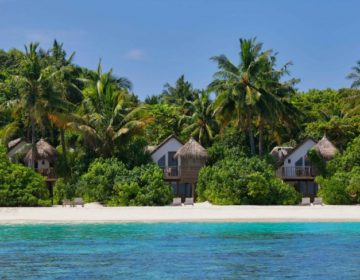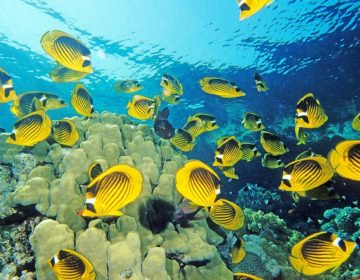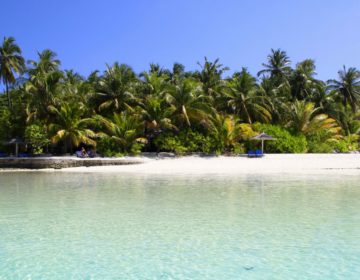The Helengeli Region lies directly below the Gaafaru Region in the North Malé Atoll, and deep, clear waters at the edges of the atoll mean excellent visibility, and sightings of large pelagics such as barracuda, trevally and tuna, and big schools of fusilier, snapper, and sharks. Most divers tend to steer away from the populated island of Malé because of heavy boat traffic. The reefs in the north of North Malé Atoll are less frequently dived than those to the south and with an absence of any islands between Helengeli and Meerunfenfushi – a distance of 20km – a sense of isolation and freedom make the dives in the northeast even more memorable.
Kagi
There is a narrow fringing house reef around Kagi and a shallow lagoon inside. On the south side of the island is a jetty; a good starting point for a house reef dive. Fish life is prolific, especially in the morning and evening. More commonly seen fish include smaller-sized flower grouper, emperor, and pelagic snub-nose pompano. Also seen along the reef edge are schooling rabbitfish. On the sandy bottom of the island lagoon are white-barred sleeper goby and swirling about in the shallows are schools of tiny herring, often being chased by baby trevally.
 Schooling rabbit fish can be seen along the reef edge.
Schooling rabbit fish can be seen along the reef edge.
Vah Kandu
The channel is quite nice around the entrance and in the middle of the channel are caves at 30 meters. Fish life includes sharks, eagle rays and stingrays. The sandy bottom of the channel lies at 25 to 30 meters.
Rassag Place
This is a channel dive on the southeast point of Thunba Falhu with a steep drop-off from three to 25 meters, then sloping more gently into the channel. There are three caves located 100 meters from the outside of the reef which is connected with swim-throughs. They start at 28 meters, rising to 15 meters. A further 100 meters inside the channel are two large caves close together, one at 28 meters and the other at 25 meters. The 25-meter cave has a huge sea fan inside. Near the caves at 15 meters are angelfish, puffer fish and file fish, and if divers look closely, they may also find well-camouflaged leaf fish.
 If divers look closely, they may also find well-camouflaged leaf fish.
If divers look closely, they may also find well-camouflaged leaf fish.
Guruwa Faru
Guruwa means sweetlips in Dhivehi, and this is the home of many oriental and harlequin sweetlips. The site lies on the north side of Dhiya Adi Kandu. Lobsters are in the shallow caves and turtles are regularly found grazing on this reef.
Fairytale Reef
On the south side of Dhiya Adi Kandu are long overhangs between 10 and 15 meters featuring delicate blue and soft yellow corals on the ceilings. During the south-west monsoon, when currents mainly flow out of the channel, giant mantas, four or five meters across, are common in groups of four or more around coral rocks on the corner at five meters. They favor this location because of the current which accelerates over the shallow reefs on the edge, bringing a good supply of zooplankton. If entering with a strong in-going current on the corner, divers should descend quickly below the surface of the reef edge to avoid being swept over the reef top.
 Giant mantas are common in groups of four or more around coral rocks.
Giant mantas are common in groups of four or more around coral rocks.
Helengeli Thila
For the sheer abundance of marine life, Helengeli Thila is hard to beat. The reef top is between 12 and 15 meters, and currents through this channel can be treacherous. The thila is about 150 meters in length. The northwest side of the Thila has the most interesting reef formation, with steep cliffs and caves and outcrops of the reef. It is only about 50 meters to Helengeli house reef but in between is a deep channel at around 40 meters. The cliffs and caves are below 25 meters and bristling with sea fans, both large and small. Four outcrops of reef rise from the depths of the channel, the most shallow being 30 meters. They are liberally sprinkled with soft coral.
Around the caves on the south side at a depth of 20 meters is a big coral covered anchor. Its origins are unknown, but there could be some connection with the 1937 tonne Swiss, which is reported to have struck the reef and sunk near Helengeli on May 29, 1890, while sailing from Pondicherry to Marseilles.
In the surrounding waters of the Thila, divers can observe a school of white tip reef sharks, interspersed with great barracuda, tuna, trevally and schools of black snapper. Schools of fusilier can be so dense they block out the light. One big rare Giant Grouper, Epinephelus lanceolatus, 1.6 meters in size, has made this reef a regular haunt. Large Napoleon frequent the site and sharks are often seen in the channel.
 Giant Grouper, Epinephelus lanceolatus, has made this reef a regular haunt.
Giant Grouper, Epinephelus lanceolatus, has made this reef a regular haunt.
Diving Hints
To observe the beauty of the sea fans and gorgonian bushes tucked away in deeper crevices and caves, it is a good idea to take a torch. If on a safari boat, as always, under no circumstances anchor on the dive site. If there is a strong current running, be prepared to abort the dive if it is too strong, especially with an outgoing current. If diving in a current, make sure safety balloons are carried and be prepared to use them when making an open water safety stop.
Kagi Kandu
There is a small bay along the northwest side of Maavaru Falhu with overhangs between 10 and 15 meters with lots of lobster inside. The sand channel bottoms out at 25 meters.
Experience these once-in-a-lifetime dives and book your hotel here.

(Source: Dive Maldives: A Guide to the Maldives Archipelago. Tim Godfrey. Atoll Editions, 2015)



